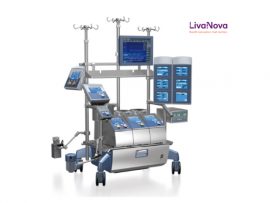Abstract Background Cardiac surgery-associated acute kidney injury (CSA-AKI) is frequent. While two network meta-analyses assessed the impact of pharmacological interventions to prevent CSA-AKI, none focused on non-pharmacological interventions. We aim..
Read MoreAbstract Venoarterial extracorporeal membrane oxygenation (VA-ECMO) use for circulatory support in cardiogenic shock results in increased left ventricular (LV) afterload. The use of concomitant Impella or intra-aortic balloon pump (IABP)..
Read MoreAbstract Background: In congenital heart surgery, low cardiac output syndrome (LCOS) is a major cause of morbidity in the immediate post-operative period. A decrease in cardiac output leads to an increase..
Read MoreAbstract The impact of blood pressure targets and surgical approach (laparoscopic or open) on continuous urinary oxygenation (PuO2), a validated surrogate of renal medullary PO2, during general surgery, is unclear...
Read MoreAbstract Introduction Growing evidence supports cardiopulmonary resuscitation (ECPR) for refractory out-of-hospital cardiac arrest (OHCA) patients, especially in experienced centres. We present characteristics, , and outcomes of patients treated with ECPR in a..
Read MoreAbstract Background Isolated limb perfusion (ILP) is a regional cancer treatment in which high-dose chemotherapy is administered in an isolated extremity. The main side effect is regional toxicity, which occasionally..
Read MoreAbstract Background Hypersensitivity reactions to heparin are uncommon conditions but pose a serious clinical problem for patients requiring cardiopulmonary bypass. Bivalirudin is a reversible direct thrombin inhibitor that can be..
Read MoreAbstract We present historical accounts of congenital heart surgery since the early 1900s, as our specialty evolved from individual heroic efforts into an established and sophisticated surgical specialty with consistent..
Read MoreAbstract Diseases affecting the aortic arch often require surgical intervention. Hypothermic circulatory arrest (HCA) enables a safe approach during open aortic arch surgeries. Additionally, HCA provides neuroprotection by reducing cerebral..
Read MoreAbstract A dysregulated host response is a common feature in critically ill patients due to both infectious and non-infectious origins that can lead to life-threatening organ dysfunction, which is still..
Read MoreAbstract Introduction Survival from refractory out of hospital cardiac arrest (OHCA) without timely return of spontaneous circulation (ROSC) utilising conventional advanced cardiac life support (ACLS) therapies is dismal. CHEER3 was..
Read MoreAbstract Venovenous extracorporeal membrane oxygenation (VV-ECMO) is a life-saving therapy for critically ill patients, but it carries an increased risk of thrombosis due to blood interacting with non-physiological surfaces. While..
Read MoreAbstract Objectives Patients undergoing cardiac surgery often require , which are associated with increased morbidity and mortality. Patient blood management (PBM) strategies, including acute normovolemic (ANH), have been implemented to minimize allogeneic..
Read MoreAbstract Unfractionated heparin (UFH) is the most used anticoagulant in patients receiving veno-venous extracorporeal membrane oxygenation (VV-ECMO). Its therapeutic levels are monitored using activated partial thromboplastin time ratio (aPTTr) or..
Read MoreAbstract Background Burnout has gained increasing attention worldwide as a phenomenon that affects health care professionals. However, there is a lack of relevant research about its impact on practitioners in..
Read MoreAbstract Background: Veno-arterial extracorporeal membrane oxygenation (VA-ECMO) is an effective mechanical circulatory support for cardiac insufficiency following cardiac surgery especially cardiac surgery with extracorporeal circulation, which can quickly restore the perfusion..
Read MoreAbstract The pathophysiology of post-cardiac arrest syndrome features ischaemic/reperfusion injury and the release of high levels of inflammatory cytokines [1]. These inflammatory markers include interleukin-6 (IL-6), C-reactive protein (CRP), tumour..
Read MoreAbstract Despite extracorporeal membrane oxygenation (ECMO) utilization in nearly 20% of cases, there are limited data in children with acute fulminant myocarditis (AFM) requiring ECMO. Herein we identify risk factors..
Read MoreAbstract A dysregulated host response is a common feature in critically ill patients due to both infectious and non-infectious origins that can lead to life-threatening organ dysfunction, which is still..
Read MoreThis case reports on an 53-year-old female patient who was admitted to the hospital with an 8 day history of fever and chills, loose stools, vomiting, severe weakness, and reduced..
Read MoreAbstract Venoarterial extracorporeal membrane oxygenation (VA-ECMO) initiation for patients with cardiogenic shock or cardiac arrest is an attractive strategy since it provides a quick restoration of organ perfusion. One major..
Read MoreAbstract Primary graft dysfunction is a feared complication and cause of mortality post–heart transplant. Primary graft dysfunction may require mechanical circulatory support, such as venoarterial extracorporeal membrane oxygenation, which carries..
Read MoreAbstract The issue of left ventricular (LV) distention during venoarterial extracorporeal membrane oxygenation (VA-ECMO) is crucial as it markedly impacts on patients’ weanability and, ultimately, outcome. Numerous techniques have been..
Read MoreAbstract Extracorporeal membrane oxygenation (ECMO) is a form of temporary cardiopulmonary bypass for patients with acute respiratory or cardiac failure refractory to conventional therapy. Its usage has become increasingly widespread..
Read MoreAbstract Background: The so-called Low Cardiac Output Syndrome (LCOS) is one of the most common complications in pediatric patients with congenital heart disease undergoing corrective surgery. LCOS requires high..
Read MoreAbstract The term heparin resistance (HR) is used by clinicians without specific criteria. We performed a literature search and surveyed our SSC membership to better define the term when applied..
Read MoreAbstract Background Current medical simulators for extracorporeal membrane oxygenation (ECMO) are expensive and rely on low-fidelity methodologies. This creates a challenge that demands a new approach to eliminate high costs..
Read MoreAbstract The rising application of extracorporeal membrane oxygenation (ECMO) has emphasized the need for consistent and standardized terminology, especially concerning peripheral percutaneous cannulation of the pulmonary artery (PPC-PA). The Extracorporeal..
Read MoreAbstract Background Extracorporeal Membrane Oxygenation (ECMO) is a high-risk, low-volume procedure requiring repetition, skill and multiple disciplines with fidelity of communication. Yet many barriers exist to maintain proficiency and skills..
Read MoreAbstract BACKGROUND: Vaso-inotropic agents are frequently used to prevent and/or treat low cardiac output syndrome in infants undergoing surgery for congenital heart disease. Due to the lack of comparative studies,..
Read More














